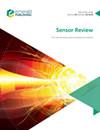利用高灵敏度的酞菁镍湿度传感器,探索机器人身体的不精确数据分析
IF 1.4
4区 工程技术
Q3 INSTRUMENTS & INSTRUMENTATION
引用次数: 0
摘要
本研究的目的是制造一种高灵敏度的湿度传感器,用于观察机器人身体的湿度效应,作为物联网的应用。该传感器是通过在两个银电极之间沉积一层薄薄的酞菁镍(NiPc)来制造的。采用x射线衍射法、紫外可见光谱法和扫描电镜法分别对薄膜的结构、光学性质和表面形貌进行了观察。用LCR计在1khz下测量了相对湿度从0到100%RH变化时的电容和电阻。结果该传感器的响应时间为7.5 s,恢复时间为3.7 s,灵敏度分别为127,259 pF/%RH和332.287 MΩ/%RH。作者还在钢体上使用了一种传感器,并观察了湿度值。所有测量值的分析均通过经典和嗜中性方法进行。通过比较,作者观察到中性粒细胞方法在分析传感器数据时更有效。在这项工作中,作者将利用NiPc薄膜制造一种电容式和电阻式湿度传感器。采用不同的表征技术,研究了NiPc薄膜的结构、光学和形态特性。电性能,即电容和电阻,将通过改变相对湿度(%RH)每隔一段时间用LCR计测量一次。此外,测量数据将通过不同的统计方法进行分析,如[12]中已经使用的。本文章由计算机程序翻译,如有差异,请以英文原文为准。
Use of highly sensitive nickel phthalocyanine based humidity sensor to explore the imprecise data analysis for robot body
Purpose The purpose of this study is to fabricate a highly sensitive humidity sensor for observing the humidity effect on a robot’s body as an application of the Internet of Things. The sensor has been fabricated by depositing a thin sensing layer of nickel phthalocyanine (NiPc) between two silver electrodes. Design/methodology/approach The structure of the thin film was observed by X-ray diffraction, optical properties by UV Vis and surface morphology by scanning electron microscope. The capacitance and the resistance with respect to change in relative humidity from 0 to 100%RH have been measured by LCR meter at 1 kHz. Findings The sensor’s response time is 7.5 s and its recovery time is 3.7 s, with high sensitivity of 127,259 pF/%RH and 332.287 MΩ/%RH. The authors have also used a proposed sensor on a steel body and observed humidity values. The analysis of all measured values was performed through the classical and neutrosophic approaches. By comparing, the authors have observed that the neutrosophic approach is more efficient in analyzing the sensor data. Originality/value In this work, the authors will fabricate a capacitive and resistive-type humidity sensor using the thin film of NiPc. The structural, optical and morphological properties of NiPc thin film will be investigated with different characterization techniques. The electric properties, i.e. capacitance and resistance, will be measured at intervals with an LCR meter by changing relative humidity (%RH). Moreover, the measured data will be analyzed through different statistical approaches, as already used in [12].
求助全文
通过发布文献求助,成功后即可免费获取论文全文。
去求助
来源期刊

Sensor Review
工程技术-仪器仪表
CiteScore
3.40
自引率
6.20%
发文量
50
审稿时长
3.7 months
期刊介绍:
Sensor Review publishes peer reviewed state-of-the-art articles and specially commissioned technology reviews. Each issue of this multidisciplinary journal includes high quality original content covering all aspects of sensors and their applications, and reflecting the most interesting and strategically important research and development activities from around the world. Because of this, readers can stay at the very forefront of high technology sensor developments.
Emphasis is placed on detailed independent regular and review articles identifying the full range of sensors currently available for specific applications, as well as highlighting those areas of technology showing great potential for the future. The journal encourages authors to consider the practical and social implications of their articles.
All articles undergo a rigorous double-blind peer review process which involves an initial assessment of suitability of an article for the journal followed by sending it to, at least two reviewers in the field if deemed suitable.
Sensor Review’s coverage includes, but is not restricted to:
Mechanical sensors – position, displacement, proximity, velocity, acceleration, vibration, force, torque, pressure, and flow sensors
Electric and magnetic sensors – resistance, inductive, capacitive, piezoelectric, eddy-current, electromagnetic, photoelectric, and thermoelectric sensors
Temperature sensors, infrared sensors, humidity sensors
Optical, electro-optical and fibre-optic sensors and systems, photonic sensors
Biosensors, wearable and implantable sensors and systems, immunosensors
Gas and chemical sensors and systems, polymer sensors
Acoustic and ultrasonic sensors
Haptic sensors and devices
Smart and intelligent sensors and systems
Nanosensors, NEMS, MEMS, and BioMEMS
Quantum sensors
Sensor systems: sensor data fusion, signals, processing and interfacing, signal conditioning.
 求助内容:
求助内容: 应助结果提醒方式:
应助结果提醒方式:


